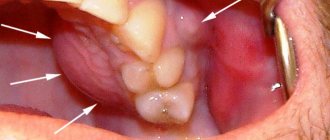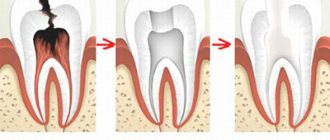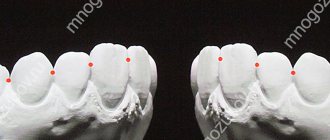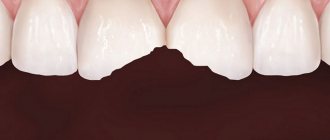Teeth are important organs that provide several human needs at once: an aesthetic effect and calmness of the nervous system, chewing food and the proper functioning of the digestive system, the formation of a bite, and therefore correct speech. At the same time, they are very delicate, and this is fraught with serious health problems for a person. If many often encounter painful caries, cysts in the gums, and destruction of the crown, then the situation when such a terrible disease as tooth cancer develops turns out to be very unexpected. If only because many people cannot even think about this type of oncology. The director of the dental studio Fedor Zakharov told AiF.ru about how tooth cancer can be hidden behind a harmless wound on the gum or a lump on the lip .
Question and answer Which brush is better: with natural bristles or synthetic?
What is the essence of the problem
The term “dental cancer” is used in everyday life, but it is not entirely correct. Yes, tumors can develop from tooth tissue: odontoma, cementoma, etc. But these are benign formations. Malignant is adamantinoma, which develops from tooth enamel, but is extremely rare and not fully understood. Most often the problem occurs in the lower jaw. Adamantinoma, in cases where it has been discovered, affects people at a fairly young age: 18-26 years. It is located in the area of the outer chewing teeth and in the corner of the mandibular bone. It can be of two types: dense and cystic. The first is a formation with a large number of cavities. The second is a formation filled with a brown mass.
The process resembles a cystic lesion of the cavity. As the tumor grows, the bone structures begin to thicken, which later combine into one bulge.
What can provoke such a terrible disease? These can be the most trivial reasons: chronic injuries to the mucous membrane, exposure to ionizing radiation, bad habits (smoking, chewing nasvay), occupational hazards (working in hot shops or dusty rooms), unhealthy diet (excessive consumption of spicy, pungent foods). In addition, there is a risk of developing jaw cancer in cancer patients with tumors of the kidneys, stomach, and lungs. In this case, they will talk about secondary oncology.
Drink milk and chew apples. How to eat for healthy teeth Read more
How does the disease develop?
The process begins with periodontitis, when the tissue located between the jaw bone and the tooth root becomes inflamed. As a result, the tissues located around the root begin to grow abnormally. Initially, the size of the neoplasm does not exceed five millimeters (it is called a granuloma). Growing and enlarging, it becomes covered with a membrane and transforms into a cyst.
There are cases when the cyst grows so much that it eats away the bone around the tooth. With the next exacerbation of inflammation, it opens, forming a channel to the outside through the gum mucosa. Such a channel is called a fistula or fistula tract.
It is worth noting once again the insidiousness of this disease, which not only negatively affects the condition of the roots of the teeth, but also affects the general condition of a person. At the initial stage, the pathology develops almost imperceptibly and can only be detected during a visit to the dentist. Pronounced symptoms appear in the later stages of the disease as a result of tumor growth and destruction of bone tissue.
The main danger of a cyst is the fact that, by corroding the bone, it deprives the patient of the opportunity to install an implant in place of a lost tooth without complex manipulations.
Dangerous symptoms
It is clear that diagnosing dental cancer is not so easy. It is worth being wary in cases where there is the appearance of long-term non-healing ulcers on the oral mucosa, deformations that are sometimes already noticeable to the eye, pain in untreated and intact teeth, when sensitivity changes. These are alarm bells that need to be responded to urgently and immediately run to the dentist. The earlier a tumor is detected, the greater the chance of minimizing losses.
It is also worth considering such an important sign as bleeding gums. If in a normal state, in order for blood to flow, you need to damage the gum, then in the case of cancer, light pressure will be enough. Also, swelling of the gums and increased body temperature may appear in parallel.
How to relieve cheek swelling after dental treatment?
In order to relieve pain in the tooth, gum and cheek after treatment, as well as relieve swelling, DD Clinic specialists recommend their patients to do simple procedures at home.
- Rinsing the mouth with an antiseptic, which will be prescribed by the attending doctor depending on the cause of the swelling;
- In case of an allergic reaction, take antihistamines, such as tavegil, suprastin, Erius, etc.;
- In case of infectious inflammation of the cheek, take antibiotics. Here it should be recalled that medications should be used only those recommended by your doctor.
When you have a toothache or need a preventative examination, come to DD Clinic - our specialists will painlessly solve any dental problems.
Treatment
Tooth cancer requires surgery. And often, after tumor removal, reconstructive bone surgery may be required. Naturally, auxiliary types of therapy will also be determined if necessary: chemotherapy, radiotherapy, etc.
What happens to your teeth if you don't brush them? Infographics Read more
Types of dental cyst
The type depends on the place of occurrence. A cyst forms in the maxillary sinus, gum, root or under the crown. To determine the type of capsule with pus, the specialist examines the medical history and assesses the client’s general health. There are 5 types of dental cysts:
- Follicular - formed when the tooth was unable to grow unhindered and most of it remained inside.
- Keratocyst - develops against the background of pathological processes during the growth of the body (the growth of the neoplasm is stimulated by the pharynx-forming tissue).
- Radicular - appears from a granuloma and is a serious complication of deep caries.
- Retention – is formed during the eruption of molars in children.
- Residual – appears due to complications and inflammatory processes after tooth extraction.
Problem statistics
Tooth cancer, like any other type of oncology, is dangerous due to its active development. And here the rule also applies: the earlier it is detected, the greater the chances of recovery. According to statistics, tooth cancer cured at stages 1-2 gives an 80% chance of five-year survival, at stage 3 the prognosis is 40%, at stage 4 - less than 15%. It is important to understand that the jaw is located close to the brain, and oncology is a metastatic disease. Therefore, you should not play Russian roulette; it is better to consult a doctor as soon as possible.
At the same time, no one has canceled prevention: even if nothing bothers you, you should visit the dentist once every six months. This will allow you to identify any pathologies at an early stage. After all, prevention is easier than cure.
Where can teeth come from in the ovary and legs from the brain?
Finding tumors with teeth, hair and even individual formed organs in the bodies of patients, surgeons of the distant past could easily accuse patients of witchcraft and collusion with the devil. Today it has long been known that such tumors - teratomas - arise due to impaired development of germ cells.
The disease is asymptomatic in 60% of cases. Problems begin only when teratomas increase in size so much that they begin to put pressure on surrounding organs. Pregnancy is considered one of the risk factors for their activation; they can also lead to complications during childbirth.
Ovarian teratomas are the most common; children also suffer from tumors - their teratomas usually form in the head area. In the vast majority of cases, teratomas are benign. However, despite being studied, their contents never cease to amaze.
My feet are in my brain
In 2008, in Colorado, doctors operated on a baby just three days old. A small tumor was discovered in his brain that needed to be removed. However, during the operation, surgeons were in for a surprise: in the child’s brain they found two feet, one of which was fully formed, the other partially formed, as well as a partially formed hand.
“Even the pathologist who opened the tumor was shocked,” they said
doctors to the press. “Perfectly formed body parts are a unique find.”
However, surgeons could not say with certainty whether the tumor was caused by a disorder of cell division or whether it was a parasitic twin that developed inside the host. In the early stages of a monozygotic twin pregnancy, when both fetuses share a placenta, one of them “wraps” itself around the other. The wrapped twin becomes a parasite and is dependent on the host twin for its continued survival. The parasitic twin is brainless and unable to survive on its own.
Surgeons from Saudi Arabia stumbled upon a similar “find” in 2000 -
in the stomach of a two-week-old boy they found
a hairy neoplasm in which they could identify two feet, two arms, a 15-centimeter intestine, brain tissue and even a penis with testicles.
Third Eye
Another tumor was discovered
in 1997 in Germany even before the birth of the child, during an ultrasound. Having identified a giant tumor in the sacral area, doctors came to the conclusion that it would be safer for the girl to have a caesarean section and surgery to remove the tumor than to wait until childbirth. The baby was born at just 29 weeks of development. The mass of the tumor was 4.5 kg, while the girl herself weighed only 950 g.
In the tumor tissues, surgeons found fragments of bone and cartilage tissue, striated and smooth muscles, blood vessels, and the intestinal lining.
But the most surprising discovery was a fully formed eye.
close
100%
Pediatric and Developmental Pathology, 1999
The tumor was diagnosed as a sacrococcygeal (sacrococcygeal) teratoma. Among newborns, the incidence of the disease is one case per 35 thousand children.
The girl was born alive. But during the operation to remove the tumor, she developed bradycardia and eventually the baby died from heart failure.
Another eye, although underdeveloped, was removed
in 2016 in Germany from the brain of a three-year-old boy. The family consulted a doctor with complaints of weakened muscles on one side of the child’s body, fatigue, and delayed speech development. MRI revealed a heterogeneous mass in the brain. Analysis of tissues after removal of the tumor showed that it contains the optic vesicle, the “embryo” of the eye, which is normally formed in the third week of embryonic development.
The tumor was completely removed, and after the operation the symptoms caused by its pressure on the brain disappeared.
Toothed ovaries
In 2015, in Brazil, a 25-year-old woman went to the doctor complaining of pain in her lower back, which had been tormenting her for two months. The initial examination did not reveal any pathologies, but an ultrasound of the pelvic organs showed
large, 10.3×9.2×8.6 cm, formation in the ovarian region.
After removal, doctors determined that it consisted mainly of fatty tissue, but the tumor also contained hair and teeth.
close
100%
Col?gio Brasileiro de Radiologia e Diagn?stico por Imagem
Teeth are not uncommon for ovarian teratomas, being found in more than a third of cases. From time to time they are even found in archaeological finds - for example, fragments of a neoplasm were found among the pelvic bones of a woman of the ancient Roman era in Spain. A small ball among the pelvic bones of an ancient Roman woman contained four teeth and a piece of bone.
.
“The outer walls of the tumor were calcified and preserved exceptionally well, given that these types of remains within the body structure are very, very fragile,” explained Assumpsio Malgosa, one of the study’s co-authors.
Another ovarian teratoma with teeth was discovered
in the remains of a woman who died in the 15th century in Portugal. The 45-year-old woman apparently died of illness and was buried in a cemetery in Lisbon. Archaeologists discovered her remains during excavations in 2010-2011. Having stumbled upon a small tumor, 4.3 cm in length, the researchers suggested that it could be an undeveloped fetus.
However, a more thorough analysis showed that the tumor contained five almost fully developed teeth - four molars and a canine.
close
100%
International Journal of Paleopathology (2017)
The woman does not appear to be suffering from a tumor, the researchers note. Judging by the fact that her skeleton was not deformed, the teratoma did not cause her any inconvenience.
Teratomas make up 24-36% of the total number of tumors in children and 2.7-7% in adults. Ovarian teratomas are one of the most common, they occur in a third of cases, as do teratomas that develop in the sacral area. 10-15% of tumors develop in the retroperitoneal space, 5-7% in the testicles, the same number in the rectum, about 5% in the chest cavity. Teratomas of the brain are the rarest.
Flux can occur in two forms:
- The acute form causes severe pain in the inflamed area, the temperature rises. Toothache is accompanied by pain in the head, radiating to the neck and shoulder. After the flux appears, the cheek swells, the general condition is depressed.
- The disease in its chronic form is not accompanied by such severe pain, but the temperature rises to 37.8 - 38.5 degrees, which confirms the presence of an inflammatory process. The swelling increases, extends to the temporal region, or descends towards the neck. The patient has difficulty speaking and swallowing.










